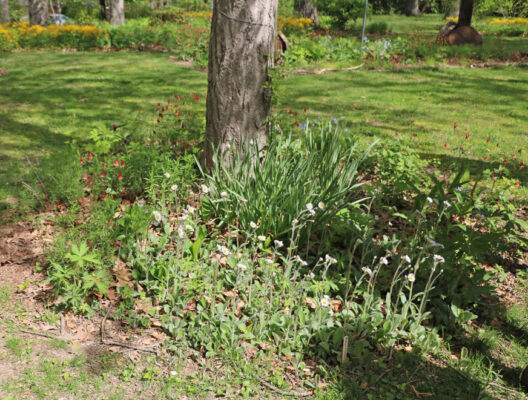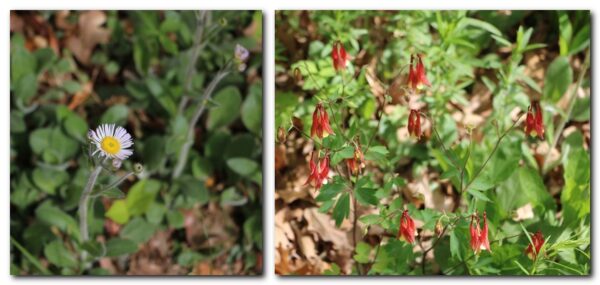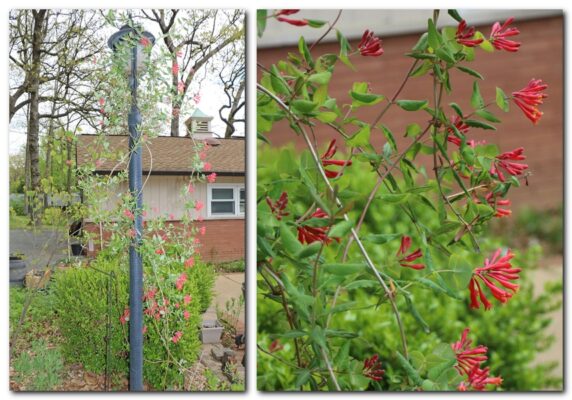post and photos by Donna Short, Chapter member and volunteer
Home of Ed and Susan Rohde
Wednesday Apr 19 (81 attendees)
Saturday Apr 22 (34 attendees)
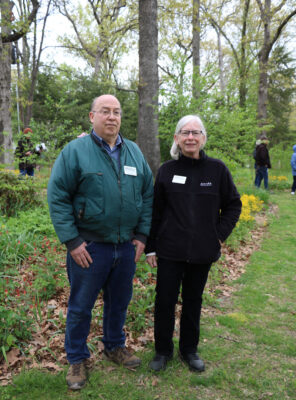 Thanks to the Rohdes for sharing this taste of spring! Ed and Susan’s native landscaping journey began in fall 2015 when they learned the dense stand of bush honeysuckle across the back of their half-acre lot was a destructive invasive species. In removing the honeysuckle and researching replacements, they discovered the benefits of native plants. In 2016, they began zealously working to replace turf grass, wintercreeper, hostas and other exotics with native understory trees, shrubs, wildflowers, grasses and sedges. In 2017 they had a Bring Conservation Home consultation with Mitch Leachman and learned what needed to be done to improve on what they had already accomplished. They soon received Silver Certification. In 2021 they received Gold Certification. Learn more about the certification levels on the BCH website.
Thanks to the Rohdes for sharing this taste of spring! Ed and Susan’s native landscaping journey began in fall 2015 when they learned the dense stand of bush honeysuckle across the back of their half-acre lot was a destructive invasive species. In removing the honeysuckle and researching replacements, they discovered the benefits of native plants. In 2016, they began zealously working to replace turf grass, wintercreeper, hostas and other exotics with native understory trees, shrubs, wildflowers, grasses and sedges. In 2017 they had a Bring Conservation Home consultation with Mitch Leachman and learned what needed to be done to improve on what they had already accomplished. They soon received Silver Certification. In 2021 they received Gold Certification. Learn more about the certification levels on the BCH website.
Saturday’s weather was cool and breezy but the first view of the Rohde’s yard definitely gave the “spring is here” feeling.
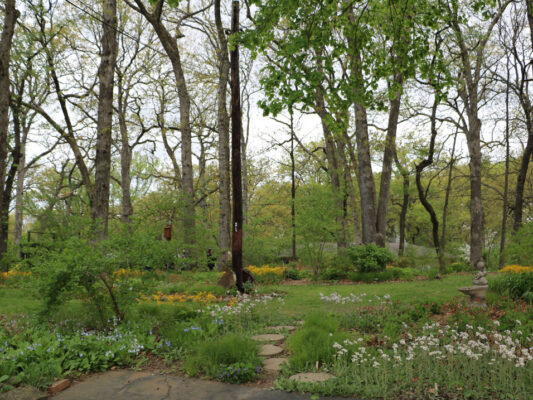
At first glance we see the yellow Golden Ragwort (Packera aurea), the Virginia Bluebells (Mertensia virginica) and the Robin’s Plantain (Erigeron pulchellus) blooming.
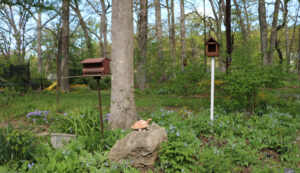
Virginia Bluebells (Mertensia virginica) are found throughout the yard, thriving in the woodland environment.
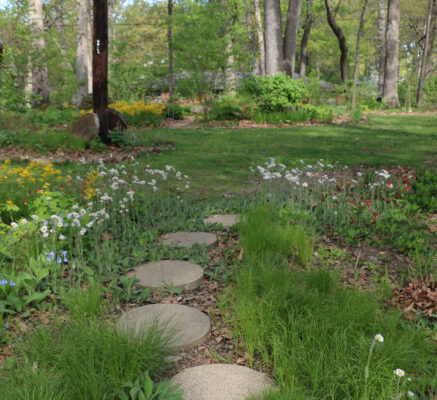
Individual garden beds surround mature oak trees, featuring over 200 species of plants – both sun and shade.
Pennsylvania Sedge (Carex pensylvanica) lines the path as we enter the garden.
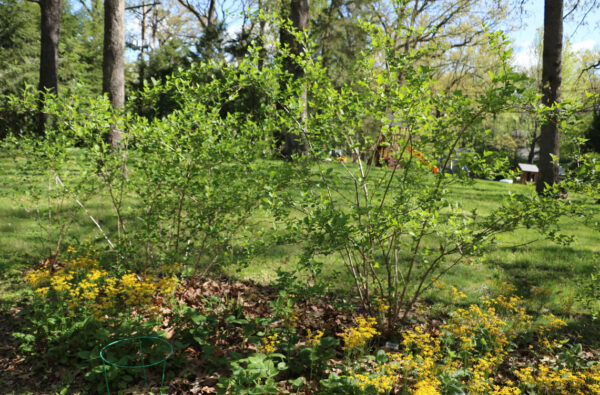
Right are Ninebark shrubs (Physocarpus opulifolius) surrounded by Golden Ragwort (Packera aurea), a sample of one of the many shrubs and small trees groups found in the yard.
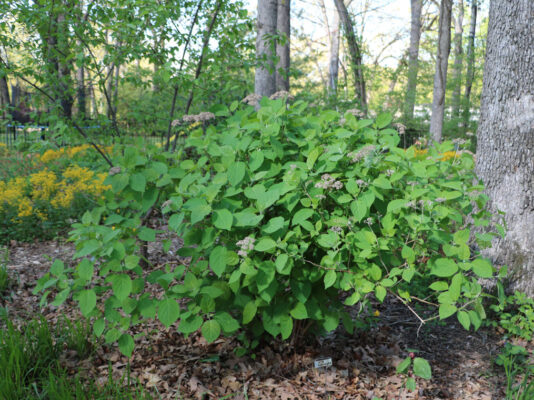
Wild Hydrangea (Hydrangea arborescens)
Note the leaves surrounding the plants. When the leaves get too deep in an area, Susan relocates most of them to the back of the yard and Ed uses the lawn mower to chop some into a finer mulch.
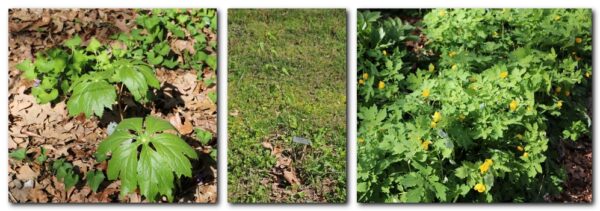
Left: Mayapple (Podophyllum peltatum) contributes to the “walk through the woods” atmosphere.
Center: Hazelnut (Corylus americana) getting started.
Right: Celandine Poppy (Stylophorum diphyllum), another spring blooming plant, is found throughout.
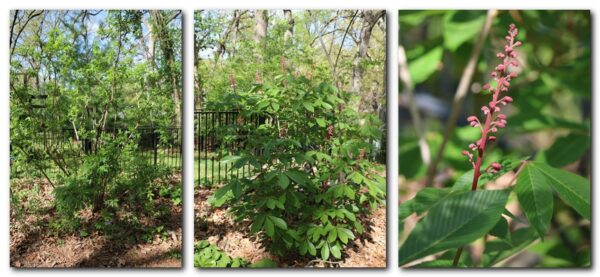
Left: Elderberry (Sambucus canadensis) and
Center & Right: Red Buckeye (Aesculus pavia)
These shrubs provide a privacy barrier along the fence line.

Continuing around the tree are these plants. Prairie Trillium (Trillium recurvatum), Virginia Bluebells (Mertensia virginica) and Dwarf Crested Iris (Iris cristata).
Here we focused on the shady backyard gardens, where the spring ephemerals were abundant. The sun-loving plants that bloom later are found in their sunny front yard.
The gardens bloom through November and include Sky Blue Aster, Aromatic Aster, New England Aster, Indian Pink, Showy Goldenrod, Gray Goldenrod, various Coneflowers, Rattlesnake Master, Wild Blue Indigo, False Indigo Bush, Swamp and Common Milkweed and many, many more.
The rocky clay soil in many of the garden beds has been a challenge but, over time, many native plants have revealed their success in these areas. Ed and Susan say it has been worth it for all the fascinating sights their native landscape has provided; such as songbirds feeding on liatris seed stalks during a snowstorm and spicebush swallowtail caterpillars munching on spicebush as well as frogs and snakes!
Also, there is a special reason to celebrate spring since St. Louis Wild Ones is marking their 25th Anniversary with a year of celebrations! Attendance prizes are awarded at each Gathering.
Refer to the highlights of the 2022 April Gathering on the St Louis Wild Ones website for a recap of last year’s April Gathering and for more information about recognizing and dealing with jumping worms.

